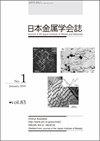Hydroxyapatite Dispersed Magnesium-Based Composite Produced from Pulverized Magnesium Alloy Powder and Its Mechanical Properties
IF 0.4
4区 材料科学
Q4 METALLURGY & METALLURGICAL ENGINEERING
引用次数: 2
Abstract
A magnesium matrix composite made of Mg–1mass%Ca and 10 vol% hydroxyapatite (HAp) particles was synthesized. The alloy powder was processed by pulverization of the small blocks of the alloy ingot using a high–speed blade grinder. Unreacted composite was successfully produced by extruding the two component powders at a temperature of 538 K. In the extruded composites, the grains of the magnesium matrix were equiaxed and the matrix grain size was 3.9 μm. As for the HAp particles, both thin clustering and severe agglomeration with the size of ~30 μm were observed. The Young's modulus, tensile yield strength and tensile strength of the extruded composite were 39 GPa, 101 MPa and 153 MPa, respectively. The damping capacity of the composite was higher than that of extruded magnesium. The composite also showed good forgeability at a temperature of 523 K. However, quite high impurity contents of Fe (0.130 mass%) and Ni (0.010 mass%) were introduced in the magnesium matrix of the composite, probably as a result of contamination that accumulates during the processing (pulverization) of the alloy powder. [doi:10.2320/jinstmet.J2017036]镁合金粉末制备羟基磷灰石分散镁基复合材料及其力学性能
合成了由Mg-1mass %Ca和10vol %羟基磷灰石(HAp)颗粒组成的镁基复合材料。采用高速叶片磨床对合金锭块进行粉碎加工。通过在538 K的温度下挤压两组分粉末,成功制备了未反应复合材料。在挤压复合材料中,镁基晶粒呈等轴状,晶粒尺寸为3.9 μm。羟基磷灰石颗粒在~30 μm范围内存在薄团聚和严重团聚现象。挤压复合材料的杨氏模量、抗拉屈服强度和抗拉强度分别为39 GPa、101 MPa和153 MPa。复合材料的减振能力高于挤压镁合金。该复合材料在523 K温度下也表现出良好的可锻性。然而,复合材料的镁基体中引入了相当高的杂质含量Fe(0.130质量%)和Ni(0.010质量%),这可能是合金粉末加工(粉碎)过程中积累的污染造成的。(doi: 10.2320 / jinstmet.J2017036)
本文章由计算机程序翻译,如有差异,请以英文原文为准。
求助全文
约1分钟内获得全文
求助全文
来源期刊

Journal of The Japan Institute of Metals
工程技术-冶金工程
CiteScore
0.70
自引率
0.00%
发文量
27
审稿时长
6-12 weeks
期刊介绍:
Information not localized
 求助内容:
求助内容: 应助结果提醒方式:
应助结果提醒方式:


